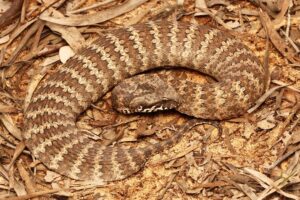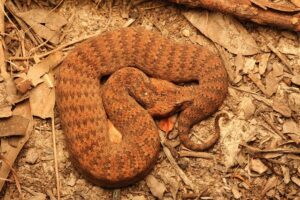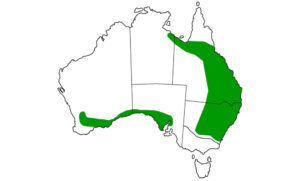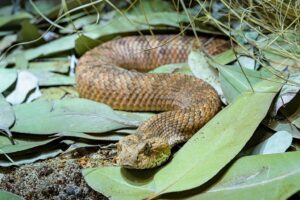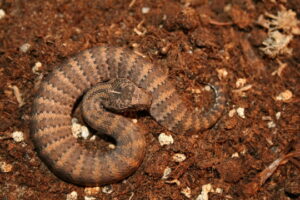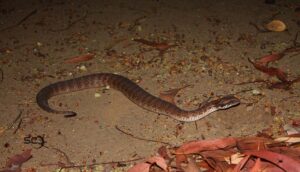The common death adder is among the most venomous land snake in Australia. It is one of the seven death adder species found there. The genus Acanthophis was established by French naturalist François Marie Daudin in 1803. The common death adder was its only species.
Their genus name ‘Acanthophis‘ derives from a mixture of two Greek words, acanthi which means ‘spine’, and ophis, meaning ‘snake’.
While this snake has a widespread distribution within its habitat, their estimated population remains unknown. They are highly solitary and possess excellent camouflage due to their body coloration.
Scientific Classifications
- Suborder:Serpentes
- Family:Elapidae
- Genus:Acanthophis
- Species:Acanthophis antarcticus
Conservation Status
Description
Size
The average length of common death adders reaches up to 27.6-36.6 inches (2.3–3.3 ft) and weighs about 1.5 lbs (700 g).
Color and Appearance
These snakes have thick bodies covered in black, brown, and red bands with cream, grey, or pink undersides. They have triangular heads that are broad and flattened, as well as thin tails. This snake possesses the longest fangs among all Australian snakes.
They have 21 – 23 smooth to slightly keeled dorsal scale rows at the midbody, 110-135 ventral scales, 35-60 primarily single subcaudal scales with some divided near the tip, and a single anal scale.
Subspecies
The common death adder has two subspecies:
- Acanthophis antarcticus antarcticus
- Acanthophis antarcticus schistos
Are they Dangerous
The death adder is a highly venomous snake, but they are not openly aggressive and avoid attracting attention. Still, if threatened or provoked, they might enter conflict with humans. They rely on camouflage instead of running away from potential treat or predators, which make them somewhat dangerous, especially to humans that roam the bushlands around their habitat.
Their bites are fatal, and the venom contains an LD50 value of 0.6 mg/kg. It can cause abdominal pain, drowsiness, enlargement of regional lymph nodes, headaches, and paralysis of extraocular muscles. They yield 70 – 236 mg venom per bite. Most people bitten by these snakes perished.
Common Death Adder At a Glance
Distribution
The distribution ranges across the eastern part and the coasts of southern Australia. They are found in New South Wales, South Australia, and Queensland. The population of this snake is scarce in the western part of South Australia and Western Australia. They also live across Papua.
Habitat
Temperate grasslands, Mediterranean forests, tropical savannas, shrublands like heath, and woodlands are preferred habitats. They mainly shelter in areas with forest debris and leaf litter since it serves as an excellent hiding place.
Lifespan
Their average lifespan is up to 9 years in the wild. However, in captivity, they can live up to 15 years.
Predators
Several predators, like the Kookaburra bird and the cane toad, prey on juveniles and hatchlings. Buzzards, crows, and large lizards like goannas target adults.
Also, adult death adders sometimes consume cane toads and get poisoned due to the toxic glands present on the toads’ skin.
Diet
The diet of these snakes consists of frogs, birds, lizards, mice, and rats. Their diet varies with age, with the juveniles consuming lizards and frogs and the adults preferring mammals and birds.
These snakes are ambush predators. They do not actively forage like other Australian snakes; instead, they hide coiling under leaves and wait for their prey to approach them while using their twitching tail as bait. Once a suitable target approaches to investigate, they strike at lightning speed, injecting their venom into it, and then wait for it to die before swallowing it whole.
Reproduction
The breeding season occurs in spring. Females give live birth during late summer; an average litter contains 3-20 young. They are precocial, which means they can hunt and move around within an hour or two after birth.
Females become sexually mature at three or four years of age, and males do so at two.
Source
southeastsnakecatcher.com.au, southeastsnakecatcher.com.au, coolcompanions.com.au, theanimalfacts.com, portaleaustralia.com, sunsoutsquamataout.files.wordpress.com

